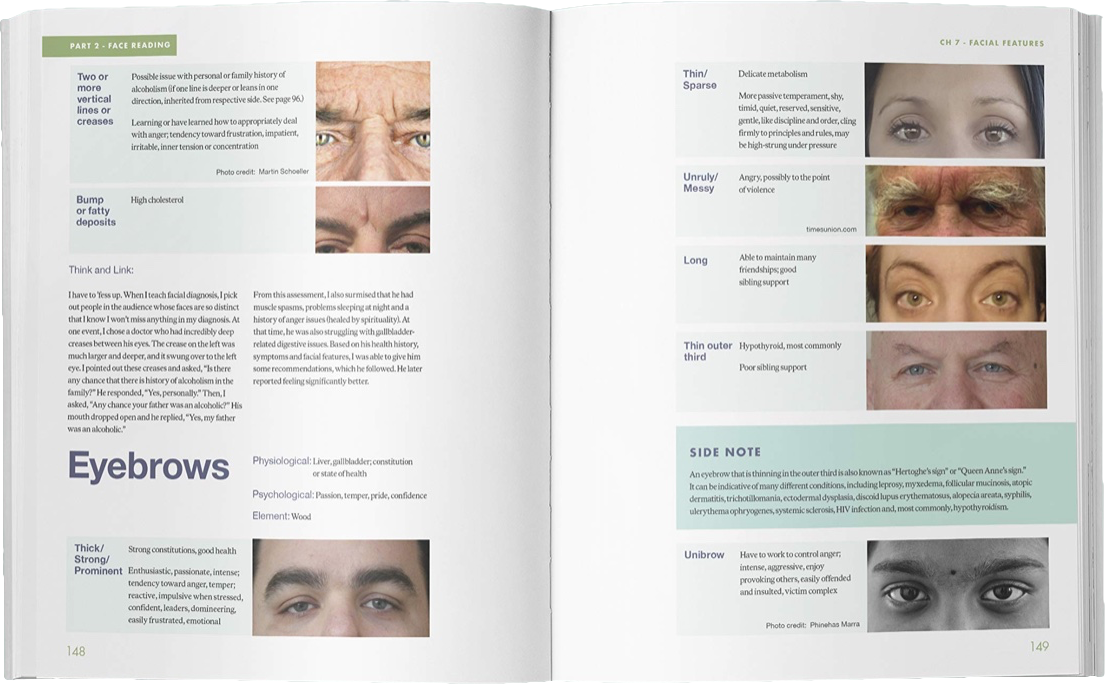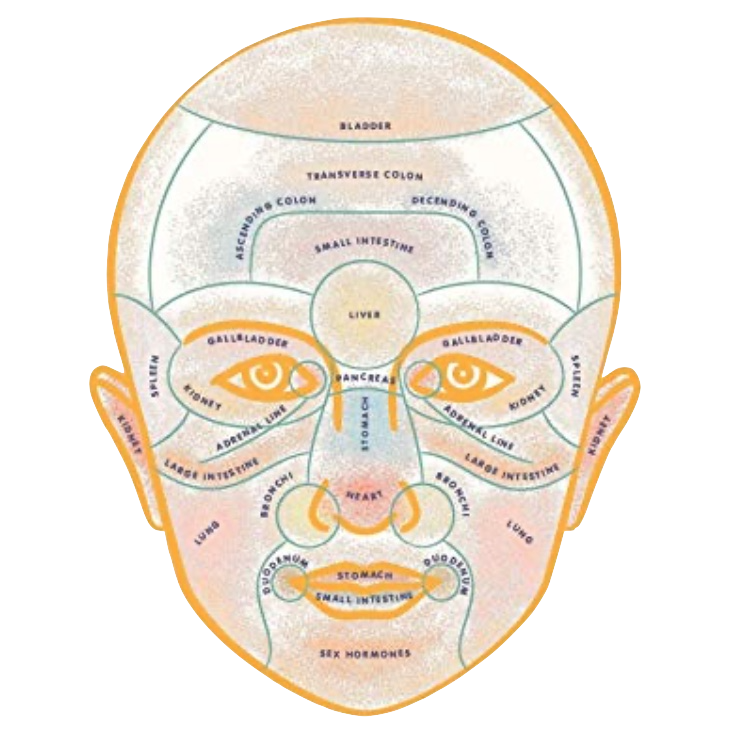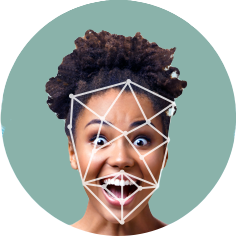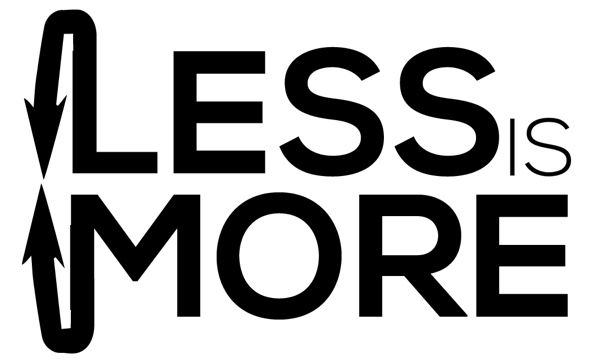Facial Diagnosis has been around for thousands of years. Dr. Todd Frisch is the leading expert in the field and best-selling author of the book ‘Why The Face’.

With advancements in Artificial Intelligence (AI) and the trend towards Telemedicine (due to COVID lockdowns these past couple years), facial diagnosis has become a powerful tool for diagnosing a wide range of emotional and physical problems with patients, using only pictures of the face.
Unlike conventional approaches to diagnostic medicine where tests can take weeks to get results, facial diagnosis can be near instantaneous using uploaded pictures of the face with assistance of AI tools. What previously took years of specialized training and practice to learn to do accurately can now be done by trained AI systems and can deliver results in seconds.
 - Dr. Todd Frisch
- Dr. Todd Frisch
Although now retired, Dr. Frisch developed terminology he uses (based on Eastern Medicine) to described the various stages of health of the body.
Referred to as "The Dis-ease model" by Dr. Frisch, there are 3 phases that are used to illustrate a patient's health, and the starting point from which their symptoms began.
The first phase is defined as "Chi", or "life force". In this phase, the patient doesn't have any major symptoms causing them to seek professional help, but they report feeling off or not quite right.
Next the patient enters the Water phase. In this phase, the patient has symptoms with no known medical cause, and all medical tests show them to be textbook midline normal. The majority of patients typically fall into this phase.
The third phase is the Blood phase. This is where medical tests (blood tests, x-rays, CTs, MRIs, etc.) will begin to show abnormalities. The patient will be labeled sick or well based on these test results. The hyphen disappears in this phase as the patient passes into the critical two-thirds sick line, and "dis-ease" becomes disease.
The Blood phase is where traditional medicine shines because there are treatment protocols in place to address the diagnosis. However, by the time a patient reaches this phase, they are already two-thirds sick.
For many diseases, two-thirds sick might be too late to detect and successfully reverse the problem. While traditional medicine was not designed to assess patients unless they cross the critical two-thirds sick line, the fundamental concept behind Facial Diagnosis is to assess "What's not right?" before a patient has reached the point where direct medical intervention is necessary.
They say an ounce of prevention is worth a pound of cure, and knowing about an underlying issue in advance of it becoming a major problem is invaluable.

By examining the distinct features of a patient's face such as eyebrow thickness, nose size, eye spacing, lines on the face, etc, facial diagnosis can reveal insights into what is happening in the body and the emotions as well as historical and inherited traits and diseases, such as alcoholism.
Genetic predispositions can also be revealed, arming a patient with the knowledge of how to combat a sickness they may be prone to before symptoms manifest.
Whether a patient is suffering from hormonal imbalances, adrenal insufficiency, constipation, kidney dysfunction, hypoglycemia, or any other ailment, facial diagnosis can reveal it. A treatment plan can then be developed with one’s doctor to improve one’s health, before serious problems ensue.
The Basics of Facial Diagnosis

The left and right sides of a person’s face display not just the relationship with maternal/paternal influences, but also thoughts and emotions. Just like irises, hands and feet, the face is a map of the body, and each major organ system is displayed on the human face.
The forehead displays the bladder, transverse colon, ascending colon, descending colon, and small intestine.
The liver is displayed just above the area between the eyes. Around the eyes, the gallbladder, kidneys, and adrenal lines are all displayed.
The ears also directly display the kidneys, while the temples display the spleen.
The bridge of the nose displays the pancreas and the stomach.
The area around the nostrils displays the bronchi (the large tubes that connect to your windpipe), and the nose tip displays the heart.
The large intestine is displayed along the cheekbones, and the lungs are displayed on the cheeks.
The upper lip displays the stomach, and the lower lip, the small intestine (along with the lower half of the forehead). The corners of the mouth display the duodenum (the first part of the small intestine which connects to the stomach), and the chin displays sex hormones.
“Less is less, and more is more" is the key tenet to facial diagnosis. If you see someone with a large nose, they likely have characteristics associated with large noses, such as greater potential for power, lots of drive and ego, ambition, independence and persistence.
If you see someone with an exceptionally large nose, they probably have even more of these qualities. People with particularly small noses will tend to have fewer of these characteristics.
The 'more is more, less is less' rule is also helpful in determining what is most diagnostic on a person's face and what is less noteworthy. When you look at someone's face, what is the first thing you see? How would you describe this person in a way that distinguishes them from a crowd? What features would a caricature artist exaggerate? These are the features that are diagnostic and noteworthy.
A person’s nose alone can reveal a lot in regards to personality and character traits. For example, a narrow nose, when viewed from the front, can be indicative of several possible traits, such as being conservative with money, a narrow outlook and range of interests, being a mega expert, valuing ideals over things, and more about quality and beauty.
A wide nose can be indicative of character traits such as being enthusiastic, optimistic, sociable, spontaneous, enjoying being on the go, dependable, capable, and diplomatic.
The nostrils are indicative of many character and personality traits of a patient as well. Turned-up nostrils indicate traits such as being sentimental, generous, and friendly. When a person’s nose is turned-down by comparison, this indicates traits such as being skeptical, clever, shrewd, good money management skills, and the ability to assess a situation at a glance.
The nose tip is the area of the face that directly reflects the heart. Redness on the nose tip can indicate possible problems with alcohol; if it turns very red in cold weather, poor circulation to the brain. Inflamed feelings, and being highly emotional, are also traits that can be recognized via redness of the nose.
Eyes are widely considered to be the windows to the soul, and like every part of the face, are incredibly revealing.
Large eyes can indicate personality and character traits such as healthy emotional and spiritual balance, naturally happy, sentimental, expressive, soft-hearted, friendly, generous, sincere, intelligent, and imaginative to name a select few.
Lower sanpaku (when there is white visible below the iris) indicates hypoglycemia; anxiety or panic attacks. Patients with lower sanpaku often tend to be tightly wound, and moody. Upper sanpaku by comparison indicates a patient suffers from an overactive nervous system, adrenal issues, hyperthyroidism, and are often nervous and/or hysterical.
Wide-set eyes, close-set eyes, narrowed eyes, and unequal sizes all reflect a patient's personality traits as well. Unequal eye levels however, indicate one side of the brain is swollen, and is common in seizure patients.
The mouth, lips, philtrum (the area between the mouth and nose), chin, jaw, forehead, nose tip, cheeks, eyebrows, brow bone, temples, and hairline contain information about a person’s emotional and physical health when examined through facial diagnosis.
Ears in particular are the most diagnostic feature in children because their faces change so quickly. The helix of the ear also reveals events that occur in ages 0-13. A thin or notched area of the helix will often be a telling sign of a significant event that had occurred at the age reflected on the helix. A creased lobe can indicate a potential inherited heart weakness, while attached lobes indicate a patient maintains connection and attachment to family, positive or negative; and/or is impulsive.
There are a myriad of details in facial diagnosis that could be misinterpreted by a layperson. Only an expert diagnostician like those trained by Dr. Frisch has the skill-set and experience necessary to accurately diagnose a patient.
Training other doctors and wellness practitioners in the modern art of facial diagnosis has been progressing over many years and there are hundreds of doctors worldwide using the techniques that Dr. Frisch developed.

Although now retired, Dr. Frisch has begun the process of training an AI tool developed in partnership with EmotionTrac to automate the facial diagnosis process.
This will make it accessible to the population at large. According to Dr. Frisch, soon you will be able to upload pictures of your face using a mobile app and receive an AI-produced facial diagnosis almost instantaneously.
Normally, a facial analysis by Dr. Frisch or one of his colleagues can take considerable time to do manually. A lengthy report needs to be written and provided to the patient. This takes too much time to produce manually, making data collection to train the AI too time consuming to be practical.
The process of training an AI to do facial diagnosis accurately is a complex one. Enough data has to be collected amongst a wide-variety of face types and features. Therefore, a software tool is being developed to speed the data-collection process.
Currently, Dr. Frisch is conducting a free clinical study for those suffering from PTSD (Post-Traumatic Stress Disorder) or TBI (Traumatic Brain Injury). The anonymous participants in this study will have their face diagnosed by Dr. Frisch using this software tool so the data to train the AI can be collected in a reasonable amount of time, something that would be impossible to do if the facial analysis is being done manually.
Using this macro software tool to speed up the data collection process, Dr. Frisch will be able to gather enough data from the study participants to then train the AI to do the facial analysis automatically.
The goal is to make facial analysis available to all via an AI-powered mobile app so problems can be detected before crossing the two-thirds sick line where medical intervention becomes necessary.
